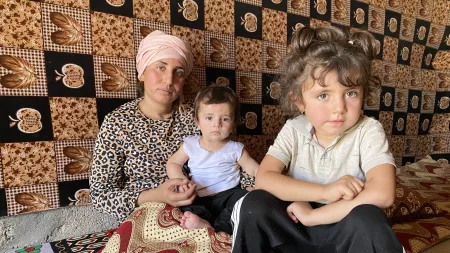Duhok, Iraq, 25 July - Ten years after the beginning of the Yazidi genocide, survivors, including women and girls, are still struggling to rebuild their lives. Ahead of the ten-year mark on August 3rd, 2024, CARE is deeply concerned about the challenges Yazidi families continue to face due to long-term displacement and the barriers that prevent them from returning home.
More than 1.1 million Iraqis, including many Yazidis, remain internally displaced across various governorates. Despite their best efforts, they are unable to return due to fear for their safety, lack of livelihood opportunities, and limited access to basic services.
“Every displaced Yazidi dreams of returning to their homeland. Sinjar, their home region, holds deep cultural and emotional significance for its people and Iraq overall."Kadry Furany, CARE Iraq Country Director
A recent CARE study revealed that the climate crisis is also hindering displaced people from returning to their homes, as changing weather patterns in Iraq make it increasingly difficult for former farmers to sustain their livelihoods. More than half of those interviewed who plan to return home expect challenges regarding income and water due to climate change.
“Every displaced Yazidi dreams of returning to their homeland. Sinjar, their home region, holds deep cultural and emotional significance for its people and for Iraq overall. But any return of the internally displaced population must be voluntary and carried out under safe conditions,” says Kadry Furany, CARE Iraq Country Director.
Yazidis forced to flee still fear for their lives if they return. The region is still experiencing tensions. The presence of armed groups poses a significant safety threat for all, but especially for women and girls, including the risk of kidnapping, rape, and violence. Villages and towns are still mostly destroyed.
According to the International Organization for Migration (IOM) of the United Nations, 80 percent of public infrastructure and 70 percent of homes in Sinjar were left in ruins and many residents' homes remain unlivable. Most of the area still suffers from severe shortages of basic services, job opportunities, and social assistance, further discouraging the return of internally displaced people. The unsafe and inadequate conditions have left displaced people both unwilling and unable to return home.
Since the end of the conflict, progress on peace and rebuilding has been notable, with approximately 4.8 million Iraqis returning to the country. But more is needed to ensure the safe, voluntary, and dignified return of all those left behind so that women and girls have access to basic social services, including formal and non-formal education, healthcare, and protection, as well as economic opportunities. CARE demands heightened international support and a holistic approach to enable all people a safe and dignified voluntary return to their homeland.
CARE and partners' response
CARE Iraq and its partner, The Lotus Flower, cover critical aspects of protection for internally displaced women, men, boys, and girls in informal settlements. They aim to reach 9,000 IDPs by raising awareness to help them make informed decisions. Field staff monitors protection and service gaps, aiming to support 1,600 individuals through case management. Cash assistance is provided to address various protection needs. Mental health support targets 2,800 individuals. Training initiatives strengthen local capacity for sustainable protection services. CARE actively participates in the Protection Platform.
For media inquiries, please contact Uta Gaiser-Hood via [email protected] or Huda Ali via [email protected].
